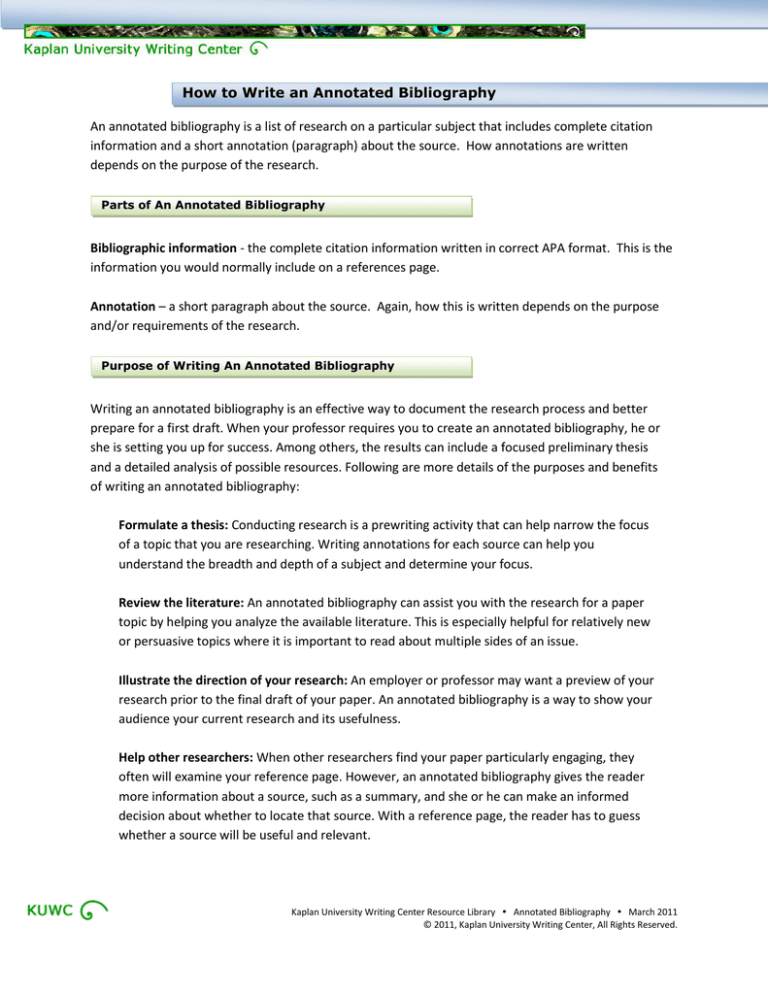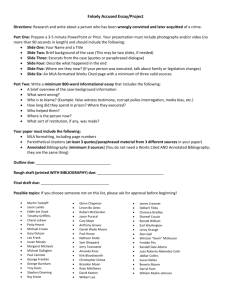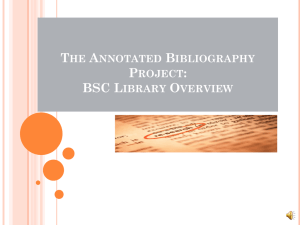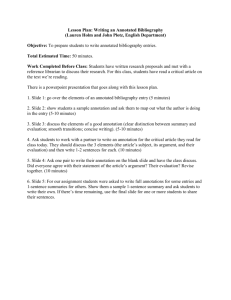
How to Write an Annotated Bibliography
An annotated bibliography is a list of research on a particular subject that includes complete citation
information and a short annotation (paragraph) about the source. How annotations are written
depends on the purpose of the research.
Parts of An Annotated Bibliography
Bibliographic information - the complete citation information written in correct APA format. This is the
information you would normally include on a references page.
Annotation – a short paragraph about the source. Again, how this is written depends on the purpose
and/or requirements of the research.
Purpose of Writing An Annotated Bibliography
Writing an annotated bibliography is an effective way to document the research process and better
prepare for a first draft. When your professor requires you to create an annotated bibliography, he or
she is setting you up for success. Among others, the results can include a focused preliminary thesis
and a detailed analysis of possible resources. Following are more details of the purposes and benefits
of writing an annotated bibliography:
Formulate a thesis: Conducting research is a prewriting activity that can help narrow the focus
of a topic that you are researching. Writing annotations for each source can help you
understand the breadth and depth of a subject and determine your focus.
Review the literature: An annotated bibliography can assist you with the research for a paper
topic by helping you analyze the available literature. This is especially helpful for relatively new
or persuasive topics where it is important to read about multiple sides of an issue.
Illustrate the direction of your research: An employer or professor may want a preview of your
research prior to the final draft of your paper. An annotated bibliography is a way to show your
audience your current research and its usefulness.
Help other researchers: When other researchers find your paper particularly engaging, they
often will examine your reference page. However, an annotated bibliography gives the reader
more information about a source, such as a summary, and she or he can make an informed
decision about whether to locate that source. With a reference page, the reader has to guess
whether a source will be useful and relevant.
Kaplan University Writing Center Resource Library Annotated Bibliography March 2011
© 2011, Kaplan University Writing Center, All Rights Reserved.
How To Write Annotations
There are several ways to write annotations depending on the purpose of the bibliography and/or the
requirements of the assignment or research. Common approaches to writing annotations include the
following:
Summarize the source: Summarizing information about a source means to state briefly the main
ideas of the source in relation to the current research. For instance, a medical book may have
multiple chapters, but the only part to summarize for this source is the information that pertains
to research for the current paper’s topic. Please note: a summary must be written in your own
words.
Evaluate the source: To evaluate a source means the writer determines the strengths and
weaknesses of the piece in relation to a particular research topic. The reliability and validity of
the source are also determined.
Reliability: This refers to the source’s credibility. Is it biased? Is the article from a
website that is also selling a product related to the subject of the article? Is there a
hidden agenda in the source?
Validity: This indicates the accuracy or correctness of the information. Is the
information gathered from experts? Is it just the opinion of the author? Is the author
an authority on the topic at hand? What are his or her professional or academic
credentials?
Reflect on the usefulness of the source: How does this source fit in with the current research
project? Is this a source you can use in your paper? Is it better suited as a starting point to find
other sources (i.e., is it useful only for background information)?
Combination: Any combination of the above approaches to writing an annotation may be
required. You may choose to write a separate short paragraph for each approach, or combine
them into one annotation. As always, it is essential that you are careful to restate things in your
own words to avoid plagiarizing the authors’ original ideas.
Kaplan University Writing Center Resource Library Annotated Bibliography March 2011
© 2011, Kaplan University Writing Center, All Rights Reserved.
Sample Citations with Annotations
Here are examples of sources that have been cited using APA guidelines and followed with an
annotation using the previously mentioned techniques. Please note which techniques or combinations
of techniques have been used.
Baker, B. (2003). Version control helps keep rework to a minimum. EDN, 48(26), 227-232.
This is a short article geared mostly toward digital developers who either are programming more than
10,000 lines of code or are programming within teams. It also emphasizes the importance of a VCS, but
more so in the development environment. For this project, the only thing I might use this for is the
simple statement that while a VCS is great for any work environment, without the discipline to use it
regularly, they are worthless.
Huber, T. (2005). JEDI version control system. Retrieved from jedivcs.sourceforge.net
This site includes detailed instructions for operating an open source VCS. It is written for a technical
audience that must have some background on this particular system. What is interesting about this
site is the idea of open source. Maybe there are other version control systems available via the
Internet through shareware sites. This particular site will probably not be used in writing the final
project, but it is a source that can lead to further research on this idea of freeware for a VCS.
McVittie, L. (2007). Version control with integrity. Network Computing, 12(21), 34-45.
This is great article with an overview of the details inside a VCS—branching, configuration, repository,
access management, and more. What makes this article valuable though is the overview of several
version control systems on the market (at least in 2001). After reading through the overview of several
products, if one fits what my company is looking for, I can begin searching for that product and further
information on the Internet. This article may or may not be used in the actual writing of the final
proposal, but it will be useful information for further research on the project.
Kaplan University Writing Center Resource Library Annotated Bibliography March 2011
© 2011, Kaplan University Writing Center, All Rights Reserved.






